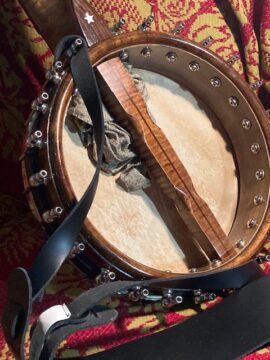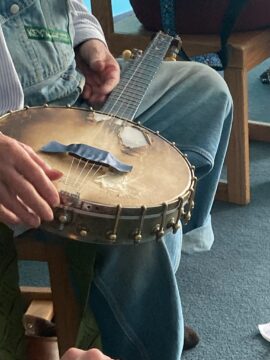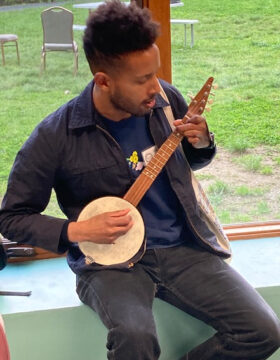by Mike Bendzela

As you slide toward retirement age, it becomes clear that you have not accomplished what you had hoped by this point in life and that the meaning of it all is still as unfathomable as it was when you were thirty. You have resigned yourself to the fact that you do not know half the things you thought you knew, but you do know for certain that what you do not know advances by orders of magnitude every day and will continue to do so long after you are dead. The boundaries of human extravagance leap forward light-years by the minute without waiting for you and there is no point in trying to keep up. Might as well spend your remaining time on the planet thumping your fingernail against a string.
*
Hundreds, perhaps even thousands of years ago somewhere in Africa, a village wag became bored with banging an animal hide-covered hollow gourd with his mere hands. So, he attached a stick to the gourd (it could very well have been she; perhaps she wanted to stir men out of their torpor), ran two or three strings of plant fiber from the top of the stick to the base of the gourd, and thumped the strings against the animal hide top, a sound that immediately seized hearts. The villagers couldn’t help dancing. It’s inspiring to know our predecessors were as bored with monotony as we are today and made stuff up as they went along. Even this short history is half fable.
*
This innovation made its way to the New World via the slave trade. Like any entity in a Darwinian universe that gains a foothold in a new geographical location, the immediate response was adaptive radiation. The entity spread widely and became fixed in the population. Mutations ensued: Gourds and fibers were substituted with wood and steel; bridges, strings and frets were added or subtracted; styles multiplied and diverged, fruitfully. One struck the strings with one’s fingernail and thumb, or with finger picks, or with plectrums. These respective cults of the banjo retreated to separate corners of the continent, appearing at square dances, in minstrel shows, on steamboat decks, finally in jazz bands and even concert halls. They would all come to rub elbows again at latter-day banjo camps.
*
You remain decidedly unenrolled in contemporary life. You have not seen a reason to turn on a television in over thirty years. There is too much to know and not enough time to learn it in. Yet there are people who think they Know Things. Politics has given license to these people’s insanity. It’s so bad you read only weather reports and obituaries in the newspaper now. You have found it best to master the blank stare and feign ignorance when asked certain questions or to say things that make people laugh at you: “I’m just going to sit here and play banjo until my teeth fall out.” There is no group that you wish to join so much as clawhammer enthusiasts in a woodland New England setting who speak Old Time.
*

While the banjar may have arisen amidst pre-modern peoples of West Africa, you find banjo camp to be an outpost of modern civilization. A chronic insomniac, you wander at 5:30 AM that first Saturday morning down a third of a mile of gravel road, enter an empty dining hall, and discover two full stainless-steel casks of hot coffee waiting there for you. After a few drafts of high-test, you notice other campers finally coming around to coffee, and you enter into a conversation with a retired journalist and woodworker from Connecticut who builds clocks and collects antique brass bells. There are software developers learning clawhammer, music teachers in three-finger classes, lawyers that have come there to fiddle. Takes all kinds to keep the tradition alive.
*
Cornucopias and buffets always present dilemmas: What shall it be Saturday after lunch? “Slides, Hammer-Ons, and Pull-Offs”? “Playing Up the Neck”? “Blues Banjo”? Wisdom means letting the weather decide. It has been pouring all day, and two of the three classes entail hiking a third of a mile back up the gravel road with your instrument. The “Playing Up the Neck” session nearby turns out to have been a good choice. The instructor, who is half your age, teaches you that there is a “magic X” fingering around the eighth fret in G tuning. Being able to play the B part of the tune “Roscoe” a whole octave higher feels like an actual accomplishment.
*
It is said at the camp that old time and bluegrass should be friends, meaning clawhammer and three-finger banjo players should get along. Well, Old Testament and New Testament should get along, too. Catholics and Protestants should get along. Jews and Arabs should get along. Liberals and conservatives should get along. Indigenous peoples and immigrants should get along. All descend from the same stock, after all. Being friends is one thing, duel membership another. The craftier players at camp can play in both styles–and even fiddle, too–but that’s as rare as hens’ dentures.
*
An old friend you have seen at jams for years has said, “The banjo is a machine.” This is distressingly true: The banjo is another unfathomable mystery of modern life. When you contacted the maker of your instrument to ask about its construction, you were flummoxed by the technical details and jargon. In short, your banjo is made of a three-ply maple rim “routered” on the bottom instead having a rim cap. The head is made of goatskin, so you will have to be careful that it doesn’t sag in humid weather. And your banjo is something of a Frankenstein: the maker used vintage hardware in its construction, salvaged “Slingerland hooks and nuts,” “Elton side ball brackets,” and “a tension hoop from an older British banjo.” You can feel yourself blanching in embarrassment at not knowing what the hell he is talking about. He says, “It’s a good idea to tighten the inside bracket bolts in case the brackets are a little loose,” but you’re reluctant to touch a thing. You will entrust your banjo to the luthier the way you entrust your car to the mechanic.
*

Banjo camp consists of a plethora of instruments, which is to say no two banjos are alike. Unlike the fiddle (violin) which is rather cookie-cutter in its incarnations, the banjo screams variability. This is not to say there are no differences among fiddles: Far from it. One encounters wood hues, scroll shapes, and ornate inlays of all types. But something about maintaining the fiddle sound keeps the instrument within certain parameters of shape and size (violas, cellos, and basses notwithstanding.) Banjos by comparison are a riot. There are long necks and short necks, with and without frets; wide pots and narrow pots; skin heads and synthetic heads; resonator backs and open backs; brackets, pegs, and doodads of all sorts. There are banjo ukuleles and banjolins. Darwin and the co-discoverer of natural selection, Alfred Russel Wallace, were both drawn to collecting beetles as boys–not beans–because of their rank variability. The banjo is the beetle of instruments, the fiddle the bean. But quelle bean!
*
A sudden downpour sends you to the Theory class in a side room that is a nursing station, something of a closet. Six of you gather among cluttered desks and medical lecture displays for a three-finger banjo player’s take on whole steps/half steps, roots and fifths, relative minors, and the mighty pie chart called The Circle of Fifths. The discussion gets bogged down because you are all ignorant with a capital I; you play, but you don’t know anything, like illiterates reciting poetry. You never get beyond the first page of the instructor’s handout. One thing about being a musical ignoramus: insights into the most patently obvious features of theory have a tendency to strike you with the force of Revelation. For example, the term “relative minor” intimidates you until you realize: Oh. It’s just the same damned notes as the major scale! And, OMG! The sixth note of any major scale always becomes the relative minor! And so on. When a young bluegrass player stares like a doe at oncoming traffic at The Circle of Fifths chart, you try to comfort him with, “Just learn your slice of the pie.” Which for you is simply C, G, D, and A.
*
One thing about such camps, banjo, fiddle or otherwise: The evening faculty shows alone are worth the price of admission. There are solos and duets and ensembles; three-finger picking fireworks–even four-finger; centuries-old fiddle/banjo tunes; group sing-alongs; corny jokes. To campers like you, these folk musicians are celebrities, yet you can mingle with them. There are two nights of these shows, and they go by too fast. The best moment: One of the older, more reputable banjo instructors sits alone on stage with his open back banjo and plays a haunting instrumental version of Stephen Foster’s song “Hard Times Come Again No More,” written in 1854 and gaining notoriety during the American Civil War. As he plays, members of the audience, unprompted, begin to sing quietly:
‘Tis the song, the sigh of the weary,
Hard Times, hard times, come again no more.
Many days you have lingered around my cabin door;
Oh! Hard times come again no more.
*
You go to banjo camp as much to play in the jam sessions as to take the courses. That means there are quite a few fiddlers at the banjo camp taking fiddling courses because–in old time music, anyway–the banjo and fiddle are a pair, peas in a pod. They are, in fact, inseparable; where one goeth, the other will follow. They are as essential as salt and pepper, a composite substance like sodium chloride, durable as bonds between protons and electrons. The fiddles chirp out the melody line while the banjos cluck out the rhythm. Guitars hum around and within phrases. Everyone in the jam session walks up, turns around, goes back to the beginning, disappearing into the tune and grinning like Cheshire cats. It’s a gas. When the tune has gone on too long, to exhaustion, like some aerobics exercise routine, the lead fiddler sticks up a foot–the signal to “Go home!”–and the tune squirrels around the last corner to its close.
*
At banjo camp, “The past is never dead,” to steal one of Faulkner’s most quoted lines. “It’s not even past.” It all comes down to those old tunes being kept alive by contemporary folk musicians. The tunes issue from the hollers and hills of the nineteenth century American south and get under your skin, which is why you’ve devoted years to your favorite machine, the banjo. Most tunes were originally dance tunes, so they are usually square, meaning they have two parts, with equal measures repeated, mostly in 4/4 time. But some tunes have irregular parts and are called crooked tunes. You can still dance to them, just typically not in square dances. Some tunes are square on the outside but a little crooked on the inside. Just listen . . .
(Tune: “Ora Lee” from Banging & Sawing. Bob Carlin, banjo; James Bryan, fiddle; Norman Blake, guitar)
These are just a few, subjective impressions of Banjo Camp North, Charlton, Massachusetts, May 17-19, 2024. The essay is not meant to represent the whole experience.
______________
Images
Photographs by the author.
